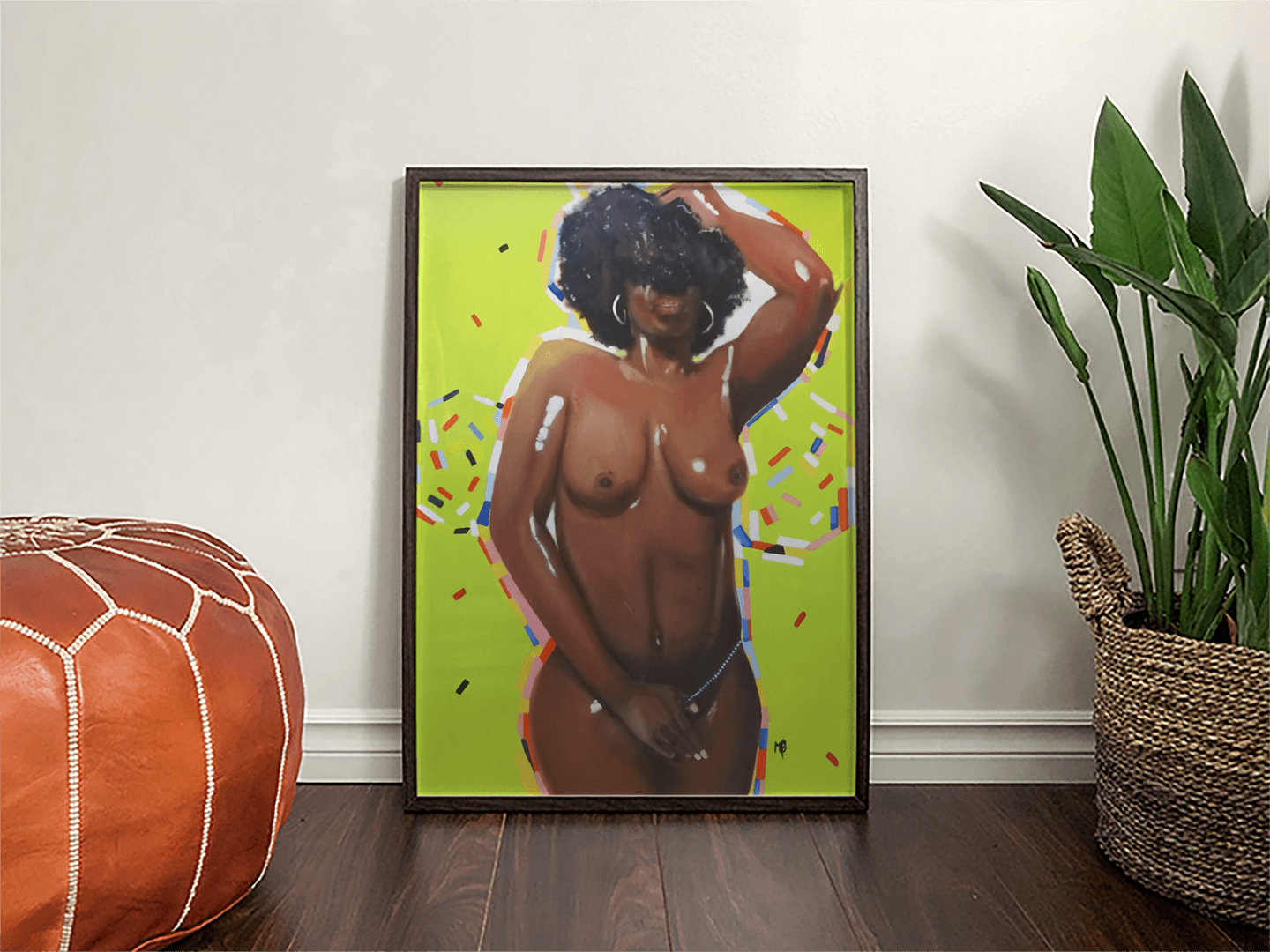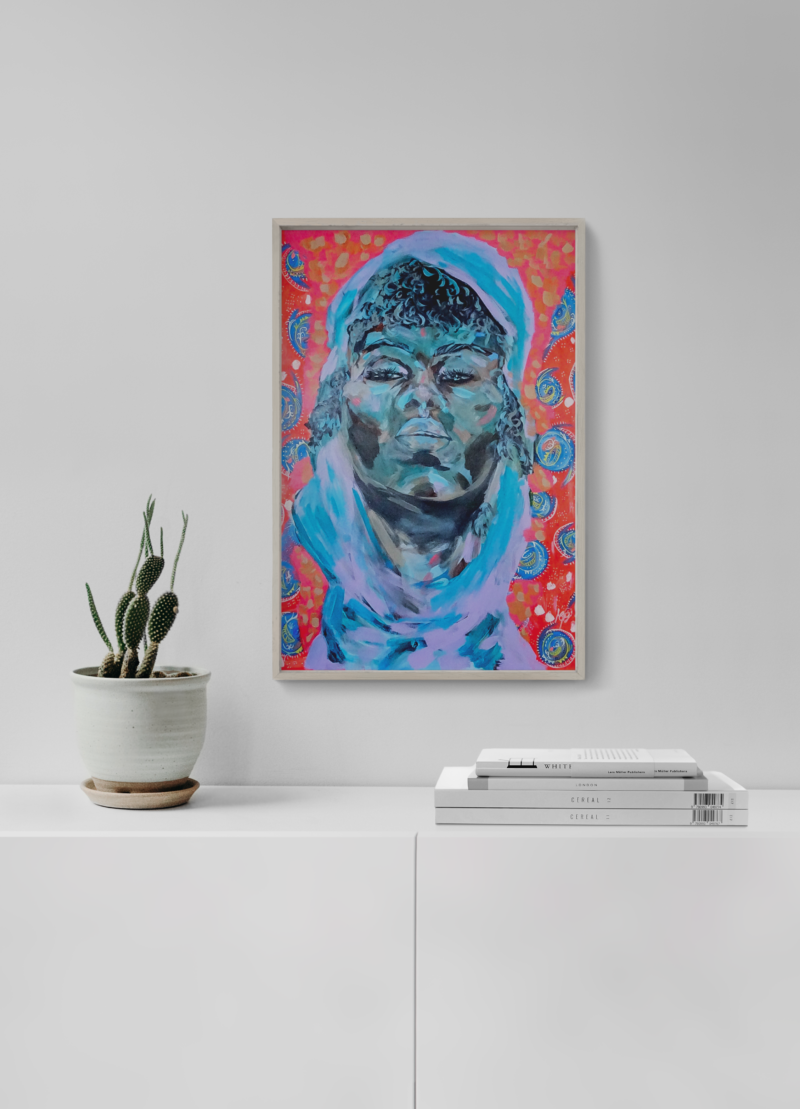
Mosaiq: A Tribute to the Liberation and Growth of Afro-Diasporic Women
Introduction
Art has always served as a vehicle for expressing the stories of those who have been silenced or overlooked. One such story that demands attention is the journey of women from marginalized Afro-diasporic groups. The painting ‘Mosaiq’ is a visual celebration of the strength, resilience, and growth of Afro-diasporic women. This oil painting encapsulates the essence of liberation and development for women whose voices are often stifled, marginalized, or ignored.
In this blog, we’ll explore the profound significance of the ‘Mosaiq’ painting, highlighting how it symbolizes the journey of liberation and growth for Afro-diasporic women. We’ll also discuss how art, particularly oil paintings on canvas and limited edition art prints, can be a medium for storytelling, preservation of history, and empowerment. Additionally, we are excited to announce that ‘Mosaiq’ is available for purchase as a limited edition art print, making it accessible to art collectors and enthusiasts who want to be part of this celebration of empowerment.
1. The Story Behind the Painting ‘Mosaiq’
The Concept of ‘Mosaiq’
‘Mosaiq’ is not just a painting; it is a deeply symbolic representation of the experiences of women from marginalized Afro-diasporic communities. The artwork features intricate layers, much like a mosaic, representing the fragmented yet resilient lives of Afro-diasporic women. Each piece of the mosaic tells a different part of the story—stories of oppression, resistance, survival, and eventual triumph.
Through bold strokes and vibrant colors, the artist of ‘Mosaiq’ captures the essence of liberation and growth, showing how these women piece together their fragmented identities, reclaim their histories, and rise to positions of empowerment. It celebrates both individual and collective journeys, and its central figure is a woman standing tall, representing not only herself but all women from marginalized groups whose stories have yet to be fully heard.
Liberation Through Art
Art has long been a tool for liberation, particularly for marginalized groups. Afro-diasporic women have historically used various forms of expression, such as visual art, music, and poetry, to assert their presence and reclaim their voices in spaces where they have been excluded.
The painting ‘Mosaiq’ stands at the intersection of personal liberation and cultural reclamation. The figure in the painting represents the breaking of chains—both literal and metaphorical—and the blossoming of new possibilities. The use of oil painting techniques on canvas allows for rich textures, giving the figure in the painting a palpable sense of vitality and resilience.
FAQs:
- What does ‘Mosaiq’ symbolize in terms of liberation?
‘Mosaiq’ symbolizes the liberation of Afro-diasporic women from historical oppression and the reclaiming of their voice, history, and identity through art. - How is liberation depicted in ‘Mosaiq’?
The central figure in ‘Mosaiq’ embodies the strength of marginalized Afro-diasporic women, with each mosaic-like piece representing fragmented experiences that come together in harmony, signifying liberation.
2. The Role of Afro-Diasporic Women in Art and Society
Representation of Afro-Diasporic Women in Art
The representation of Afro-diasporic women in art has historically been limited, often reduced to exoticized or stereotyped portrayals. However, in recent years, there has been a growing movement within the art world to not only feature Afro-diasporic women but to do so in a way that accurately reflects their complex identities, struggles, and triumphs. ‘Mosaiq’ is a proud example of this, positioning an Afro-diasporic woman at the center of a narrative of growth, strength, and empowerment.
Through this painting, the artist highlights the critical roles Afro-diasporic women have played in shaping their communities, fighting for equality, and leading movements of social and cultural change. The figure in ‘Mosaiq’ is depicted with dignity and grace, standing as a testament to the resilience of generations of women who have fought for liberation and progress.
Growth and Development Through Adversity
One of the central themes in ‘Mosaiq’ is growth through adversity. The mosaic pattern in the painting symbolizes the fractured experiences of Afro-diasporic women, many of whom have had to navigate systems of racial and gender oppression. Despite these challenges, the women represented in ‘Mosaiq’ continue to grow and thrive, developing not only as individuals but as leaders within their communities.
The painting serves as a reminder that growth often emerges from hardship. The vibrant colors and intricate patterns symbolize the multifaceted nature of Afro-diasporic women’s experiences, while the central figure’s stance signifies triumph over adversity.
FAQs:
- How does ‘Mosaiq’ represent the growth of Afro-diasporic women?
‘Mosaiq’ uses a mosaic pattern to symbolize the fragmented yet resilient nature of the lives of Afro-diasporic women, showing that despite hardship, they continue to grow and develop. - What role do Afro-diasporic women play in art?
Afro-diasporic women in art represent the intersections of race, gender, and culture, using their work to reflect their lived experiences and challenge societal norms.
3. Art as a Medium for Liberation and Empowerment
Oil Paintings on Canvas: A Timeless Medium for Storytelling
One of the reasons why oil paintings on canvas have remained a favored medium for centuries is their ability to create depth and texture. In ‘Mosaiq,’ the artist uses oil paints to bring a sense of richness and vitality to the composition. The use of oils allows for vivid, nuanced colors and a tactile surface that makes the painting come alive.
Oil paintings, especially those that deal with significant cultural and historical themes, like ‘Mosaiq,’ have the ability to stand the test of time. The meticulous application of layers of paint in this artwork mirrors the complex layering of the life experiences of Afro-diasporic women.
Limited Edition Art Prints: Accessibility and Collectability
Art is a powerful tool for storytelling, and making ‘Mosaiq’ accessible to a wider audience is essential. To this end, limited edition art prints of ‘Mosaiq’ are available for purchase, allowing art lovers and collectors to own a piece of this important cultural commentary. These prints maintain the integrity and vibrancy of the original oil painting while making the artwork accessible to those who may not be able to invest in the original piece.
Limited edition prints are particularly valuable for collectors, as they provide an opportunity to own a numbered, signed version of the artwork, ensuring its authenticity. Moreover, these prints allow for the democratization of art, making important works like ‘Mosaiq’ available to a broader audience who can connect with its powerful message.
FAQs:
- Why are limited edition art prints important?
Limited edition art prints maintain the integrity of the original work while making it accessible to a wider audience. They are also valuable for collectors as they ensure authenticity and exclusivity. - How does ‘Mosaiq’ use oil painting techniques to tell a story?
‘Mosaiq’ uses oil painting techniques to create depth, texture, and vibrancy, which help bring the story of Afro-diasporic women’s liberation and growth to life.
4. The Importance of Supporting Afro-Diasporic Artists
Cultural and Economic Impact
Supporting Afro-diasporic artists, particularly women, is not only important for cultural representation but also for economic empowerment. By purchasing art from marginalized communities, collectors and patrons are helping to elevate voices that have historically been silenced. This not only contributes to a more diverse and inclusive art world but also ensures that Afro-diasporic artists can continue to produce work that challenges societal norms and tells their unique stories.
The Growing Demand for Afro-Diasporic Art
The art world is seeing a growing demand for works from marginalized communities, particularly from the Afro diaspora. Collectors and galleries alike are beginning to recognize the importance of diverse voices in shaping the cultural landscape. By investing in works like ‘Mosaiq,’ buyers are not only acquiring a beautiful piece of art but also supporting a movement toward greater inclusion and representation in the art world.
FAQs:
- Why is it important to support Afro-diasporic artists?
Supporting Afro-diasporic artists helps to elevate marginalized voices, contribute to cultural representation, and empower artists economically. - What is the current demand for Afro-diasporic art?
The demand for Afro-diasporic art is growing as collectors and galleries seek to diversify their collections and support underrepresented artists.
Conclusion
The painting ‘Mosaiq’ stands as a powerful testament to the liberation, growth, and development of Afro-diasporic women. Through bold use of color, intricate mosaic patterns, and the timeless medium of oil paint, the artist captures the essence of resilience, empowerment, and triumph over adversity. By purchasing a limited edition art print of ‘Mosaiq,’ collectors and art lovers alike can take part in
Ontdek meer van Fine Art, Art Prints & More
Abonneer je om de nieuwste berichten naar je e-mail te laten verzenden.









